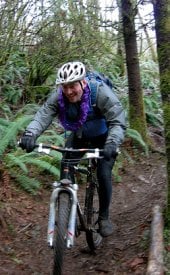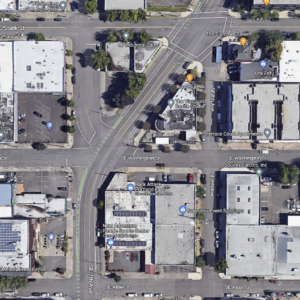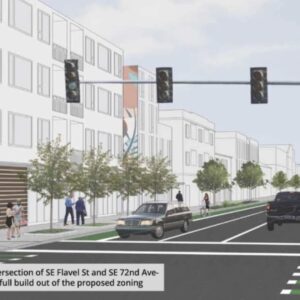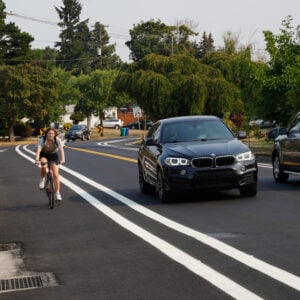
(Photo: Jordan Norris)
Local mountain bike advocates are working to strengthen their relationship with a timber company in Scappoose.
Longview Timber, LLC owns a large tract of land just 20 miles north of Portland that has become a popular riding area over the years. The problem is, while Longview has been gracious in allowing people to ride bikes on their property, the ad-hoc trail network is not signed and some riders have been caught in prohibited areas (sometimes going right under caution tape). Last summer during fire season, Longview representatives reached out to the community to urge compliance with closed areas.
Tom Archer, president of Northwest Trail Alliance (NWTA), says a network of cross-country trails have been built over the years, but the situation has worsened due to new freeride and stunt trails that have shown up recently. Longview Timber, worried about liability, sent the NWTA a letter saying that they’d close the area entirely if more wasn’t done to prohibit the new trails and keep people out of prohibited areas.
“Our hope is that if we do this right, we can maintain existing access – which is in jeopardy – and in the long term we might even be able to expand the trail network.”
— Tom Archer, NW Trail Alliance
[Note: The reason freeride and stunt trails are an issue (as opposed to cross-country trails) is because they encourage a more dangerous type of riding.]
Two weeks ago, representatives from Longview and NWTA sat down to discuss these issues. Archer came away cautiously optimisitc. “They are looking to us to be a voice to the community. They realize we are the only channel they can use to get the word out.”
As part of an agreement reached at the meeting, the NWTA will do an inventory of current trails (including where trails need to be repaired and/or re-routed), educate their members, and create a proposal that helps Longview get a handle on existing problems. Archer says,
“They’re looking at this as a way to formalize the relationship… Our hope is that if we do this right, we can maintain existing access – which is in jeopardy – and in the long term we might even be able to expand the trail network.”
If it all goes according to plan, Archer says Longview Timber and the NWTA will sign a formal trail agreement.
Archer understands that Longview has no obligation to allow biking on their land at all, so he’s taking this opportunity very seriously:
“They didn’t promise us anything, but it seems like there might be some opportunities to move things forward in a positive way, but only after we get our house in order. They’ll have to see an improvement on what’s going on out there first.”
Longview has expressed to Archer that they do see a benefit in having more riders on their land. Shooting, trash dumping, and partying has decreased as the area has become more popular for mountain bikers. But, the negatives outweigh the positives, so NWTA has work to do.
To learn more about this situation and to help make it better, come to the NWTA general meeting tonight. Due to large attendance at recent meetings, the group now meets at Roots Brewing in Southeast Portland. More details here.







Thanks for reading.
BikePortland has served this community with independent community journalism since 2005. We rely on subscriptions from readers like you to survive. Your financial support is vital in keeping this valuable resource alive and well.
Please subscribe today to strengthen and expand our work.
The lack of signage makes it harder to understand which trails are ok and which aren’t. Obviously caution tape is clear and people need to stop doing things like going under the tape. However my understanding is that the lack of signage is at the request of the property owner, who asked that signs that were up be taken down. I hope that this process will allow signage to return.
Also thanks a lot to Longview Fiber for not overreacting and shutting the whole place down due to the actions of a few people who are breaking the rules. An example I’d like to see Forest Park follow.
Bjorn,
you’re correct, it’s not clear in my really, but Longview is in a tough position– On one hand they want all the trails to be under the radar and they don’t want maps, signage, etc… — but on the other hand they realize people are riding their and they want compliance. This is why it’s so crucial for 1) people to respect what signs they do see and 2) for NWTA to get more involved.
I suggest Archer consult counsel re: the Oregon statute that relieves landowners of all liability for injuries to people engaged in recreation on their land. People don’t seem to know about this, including Longview. I encountered the same issue with Weyerhaeuser on their land in the Coast Range.
Velophile
Although liability is a concern to Longview, it is not their top concern. They are concerned about damage to their resource in the form of increased erosion, cutting of trees, etc. Longview manages to the Sustainable Forestry Initiative standards and as such, everything on the land has value. Safety is also a concern – we need to respect closures to due to fire hazard and active logging operations. There have been incidents where bikes ducked the tape and rode into active logging operations. Also, just because landowners may not be liable, it does not prevent someone from suing, which then requires the landowner to defend themselves.
I would aslo not that the freeride and downhill activities that have sprung up out there, while arguably more dangerous, are a concern due to the clearing, treecutting etc. There have been some pretty blatant actions out there, which NWTA/PUMP stepped in to clean up in the past. There may even be a chance for these activities to occur, but they would have to be done in the appropriate manner and approved by the landowner.
There’s more to share, so if you;re interested, show up at our meeting tonight.
Tom Archer
President – Northwest Trail Alliance
Trillium has a good relationship with mountain bikers in Bellingham on Galbraith Mountain maybe there agreement could be used as a model.
http://www.trilliumcorp.com/past/galbraith/
http://www.whimpsmtb.com/archive/Old%20WHIMPS%20site/galby.htm
And, Trillium has allowed FR/DH style trails for years on Galbraith mountain…
I hate to see this type of riding constantly vilified and excluded in Portland as impossible to accommodate.
@ #4: Thanks for the info, Tom. Would NWTA consider purchasing or leasing timberland near Portland?
In doing so, NWTA could more directly control activity on the land and would gain the opportunity to demonstrate responsible trail building and use. It might be a good project for a partnership with a conservation organization, which could also model sustainable forestry practices while the timber resource repays the initial investment.
Velophile,
We absolutely would consider it, though the funding would be a hurdle. I don’t think it’s insurmountable – there is a lot of interest to create a bike specific area in close proximity to Portland. If you have any ideas, please send me an email via our website.
Tom Archer
President-Northwest Trail Alliance
I’ve ridden the xc trails up past the blue gate before. I never heard about existing freeride trails (I know some illegal stunts were demolished a while back), but I saw some people on DH bikes riding down Rocky Point Road, followed by a brown Toyota Scion with rack on the back- they turned RIGHT off the road onto a trail (down into an area I didn’t know was developed). I followed the Scion down the hill, and saw it turn south on the highway, then park at a gated road down at the bottom of the hill. I wondered, at the time, if this kind of high intensity shuttling exercise was allowed on the land. I bet not!
Step one: Make DH riding seem evil, unsustainable & overly dangerous.
Step two: “Decommission” DH trails to show that you’re good land stewards.
Step three: Watch as more and more illegal DH trails show up in various locations because a recreational need is not being met.
I can’t imagine it would be that hard to adopt existing DH trails, reroute unsustainable sections and accommodate DH riding in Scappoose with Longview’s blessing.
Charley, high-intensity is up to the individual rider. I’ve ridden the existing XC system intensely and the DH trails gingerly. Shuttling on a paved road with adequate parking doesn’t seem all that evil or illegal.
Zimm,
I’d like to see FR/DH riding expanded as well and NWTA is stepping up it’s efforts in this area (as one example we are working toward formal adoption of the small Freeride/Dirt Jump area at Sandy Ridge). But it’s gonna take time.
I’m not trying to villify the activity, simple passing on my observations about how the trails were built – fall lines, poorly built jumps and stunts, no consideration for erosion potential and a disregard for the owners cash crop (trees).
We had no choice but to decommission certain trails and stunts if we wanted continued access. The owner demanded it. There may be an opportunity to expand this type of riding in the future, but only if we get our house in order AND if those that have created these types of trails in the past get involved with legitimate means of creating the types of riding they want to see, instead of continuing to build without permission. We can’t just keep battling each other in the woods and in these forums.
Nuff said.
Tom Archer
President-Northwest Trail Alliance
I saw a series of large jumps built on a private forest logging road that were so big it would probably have been somewhere between difficult and impossible to drive a full size truck down the road. When stuff like that happens it creates nothing but problems. Freeride areas are being developed, look at black rock, but throwing that kind of stuff up willy nilly in places where it is highly visible/disruptive of the primary use of the property is not going to help anyone.
as much as I hate the lack of flow at these trails, Scappoose is the only trail system near the city. This area needs to become official.
When a hypothetical guy with a shovel sees a ton of trail building activity in an area, and it seems to be completely free-for-all, how is he supposed to know it’s not OK to build some jumps when people have been building poorly designed trails in that same area for many years? I think the area just needs some active management and signage – thanks NWTA for taking the lead. And a HUGE thanks to LF for not kicking everybody out.
No longer digging: If John Joy, the guy who built the scapoose trails, owned a computer, he could detail the process he used to develop the trails with permission from the former land manager. That is the important part, “WITH PERMISSION”, and the lack of flow is intentional, it keeps the riders riding slow. Enjoy the view!
the view of trees planted too close together…
The photo on this story is not a good advertisement for bikes and hikers using the same trail in the Forest Park. Can you imagine a hiker being passed by a biker on that mudhole trail and getting mud splattered all over them? THAT would not make the hiker happy. AND that is just one of the problems – being run over being a more serious one.
I’m all for single track for bikers, BUT the photo is an example of why it is not compatible with hikers using the same trail at the same time.
Someone suggested alternate days for bikers and hikers. That might work.
#17 Please read the article. This is a story about trails on Longview timber land in Scappoose, not Forest Park.
I should note that aside from a few incidents with off-leash dog attacks there doesn’t seem to be much of a conflict on the Scappoose trails between hikers and bikes. All my personal experiences have been positive. If I encounter someone hiking I stop, step aside, say hello and then carry on riding. There’s a trail etiquette to follow…
Hiking and biking being incompatible is a fallacy. I’ve ridden plenty of multi-use trail systems without incident.
WAY DOWN in the deep south of southern Tennessee and northern ‘Bama is a club that owns a lot of land that they manage for hunting/horse riding/photography and other types of outdoor recreation, including mountain biking. You can get a REAL GOOD batch of chigger bites down there. Mountain bikers can purchase an annual permit. Here’s the link to their website:
http://www.deepsouthoutdoors.com/page.php?10
Perhaps local land owners would be OK with a similar program, although if it were a tad cheaper that would be OK too.
#18, I understand this article is not about FP.
Currently debate rages in the community about whether bikes and hikers can share trails IN FP. My point is that if a bicycle passes a hiker on a muddy trail such as the one in the photo the hiker will be splattered with mud and that will make them unhappy.
I’m ALL FOR bikers having some single track trails to ride on, including in FP if everyone can agree on which trails, either existing ones or new ones.
However, as a hiker and biker, I would not want bikes using the existing FP trails with hikers at the same time. The trails are narrow, and in the winter, they are a muddy slophole mess.
#21, Here are the IMBA’s trail etiquette guidelines:
http://www.imba.com/about/trail_rules.html
I’ve personally ridden plenty of multi-use trail systems in the US & Canada with these posted at trailheads. It’s pretty straightforward: bikes yield to all other trail users. It’s hard to get mud splattered by a bike that way.
Your #17 post reminds me of the way they do it at the Kingdom Trails in East Burke, Vermont. Day users can pay a $10 fee for access or you can purchase a season pass that helps pay for ongoing trail maintenance. Personally, I’d pay for this kind of access to a legit & protected trail system.
http://74.54.24.214/~kingdom/membership
It works elsewhere, why not here?